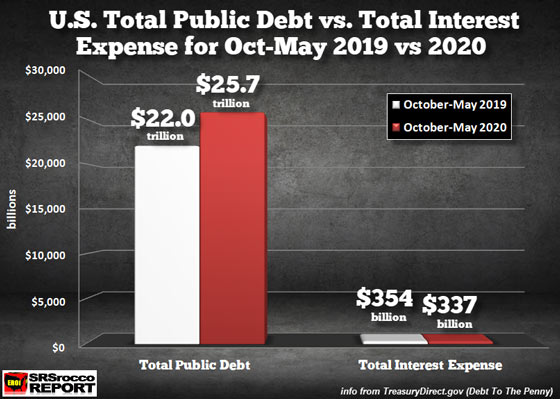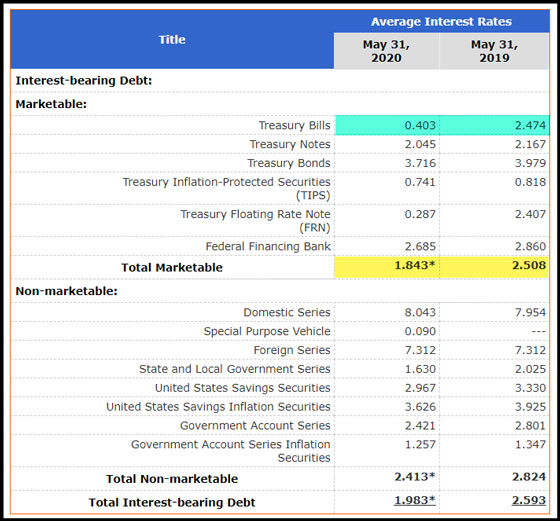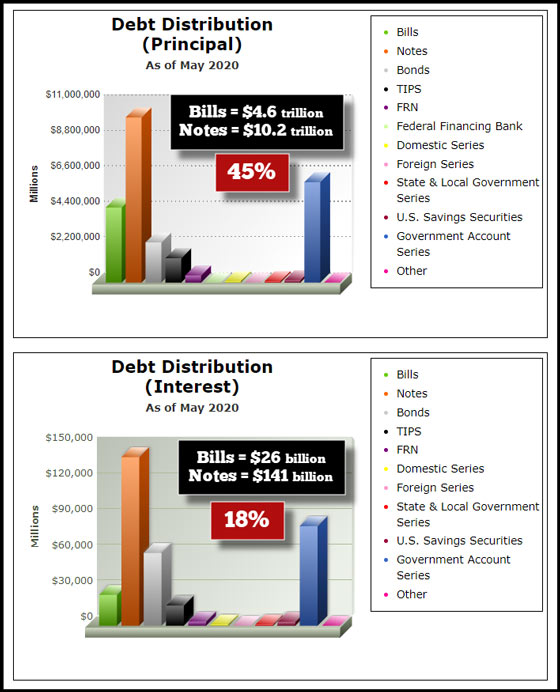By Money Metals News Service
If Americans thought the U.S. Government would be in serious trouble as its ability to service its ballooning debt would become unmanageable, guess again. After the U.S. Government added nearly $3 trillion more debt in just the past eight months (fiscal year), the interest paid on the public debt actually declined versus last year.
According to TreasuryDirect.gov, the U.S. public debt increased from $22.8 trillion to $25.7 trillion during fiscal 2020 (October to May). Thus, total U.S. federal debt has increased by nearly $3 trillion in eight months compared to $1.2 trillion last year… for the entire year!! So, with $3 trillion more debt on the U.S. Government’s balance sheet, you would think the interest expense would have also increased.
NOPE… the U.S. Government paid $337 billion of interest expense so far this year (Oct-May) compared to $354 billion during the same period last year:

How did the U.S. Government get away with paying less interest expense on $3 trillion more debt?? The U.S. Government was able to lower its interest expense because the interest rate on the debt declined significantly over the past 12 months. The average interest rate on U.S. public debt in May 2019 was 2.50% compared to 1.84% in May 2020, highlighted in (YELLOW).

However, the biggest factor that pulled down the average interest rates was the change in the rate of U.S. Treasury Bills highlighted in BLUE. The Treasury Bill’s interest rate fell from 2.47% in May 2019 to 0.40% in May 2020. That’s a massive decline in the interest expense paid to Treasury Bill holders.
Free Reports:
 Get Our Free Metatrader 4 Indicators - Put Our Free MetaTrader 4 Custom Indicators on your charts when you join our Weekly Newsletter
Get Our Free Metatrader 4 Indicators - Put Our Free MetaTrader 4 Custom Indicators on your charts when you join our Weekly Newsletter
 Get our Weekly Commitment of Traders Reports - See where the biggest traders (Hedge Funds and Commercial Hedgers) are positioned in the futures markets on a weekly basis.
Get our Weekly Commitment of Traders Reports - See where the biggest traders (Hedge Funds and Commercial Hedgers) are positioned in the futures markets on a weekly basis.
And, if we look at the next chart, we can see that in May 2020, the outstanding U.S. Treasury Bills, which accounted for $4.6 trillion, was 45% of the $10.2 trillion of Treasury Notes. But, the total interest expense paid during Oct-May from these Bills was only $26 billion (18%) compared to $141 billion paid from the outstanding Treasury Notes. Simply put, with total U.S. Treasury Bills being a little less than half of the Treasury Notes, the interest paid on these Bills was only 18% of the Notes.

Of course, the falling interest rate on the Treasury Bills was partly due to the enormous Stock Market sell-off as investors moved out of stocks and into Treasuries for protection. But, the Treasury Bill interest rate should have bottomed in March to coincide with the bottom in the U.S. stock indexes… CORRECT? NOPE.. again. Here are the Treasury Bill’s interest rates for the past five months:
Treasury Bill’s Interest Rate:
- Jan 2020 = 1.68%
- Feb 2020 = 1.64%
- Mar 2020 = 1.22%
- Apr 2020 = 0.60%
- May 2020 = 0.40%
With the Dow Jones Index ROARING BACK from a low of 18,200 on March 23rd to a high of 25,750 at the end of May, a staggering 41% increase, wouldn’t the Treasury Bill’s interest rate head back higher??? Yes, it would have if the Federal Reserve wasn’t buying Trillions of U.S. Treasuries. By the Federal Reserve adding Treasuries to its balance sheet, that has kept the Treasury Bill’s interest rate artificially low, thus paying Bondholders less for holding the debt… LOL.
Most Americans have no clue that the U.S. Economy and Financial System are one giant PONZI SCHEME. And, as this Ponzi Scheme grows exponentially larger, the reason to own PHYSICAL PRECIOUS METALS becomes even more important. In the past, if an investor were smart, they would allocate about 5% of their assets to physical gold and silver. Now, it seems prudent that is should be at least 25%.
 The Money Metals News Service provides market news and crisp commentary for investors following the precious metals markets.
The Money Metals News Service provides market news and crisp commentary for investors following the precious metals markets.